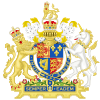Lord High Treasurer
| Lord High Treasurer of the United Kingdom | |
|---|---|
Second Lord of the Treasury Lords Commissioners of His Majesty's Treasury |
The Lord High Treasurer was an
The Lord High Treasurer functions as the head of His Majesty's Treasury. The office has, since the resignation of Charles Talbot, 1st Duke of Shrewsbury in 1714, been vacant.
Although the
Section 2 of the Consolidated Fund Act 1816 also provides that "whenever there shall not be [a Lord High Treasurer of the United Kingdom of Great Britain and Ireland], it shall ... be lawful for His Majesty, by
Origins
The English Treasury seems to have come into existence around 1126, during the reign of

The office of Lord High Treasurer is distinct from that of Treasurer of the Exchequer. The Lord High Treasurer was appointed by the delivery of a white staff to the appointee, and the Treasurer of the Exchequer was appointed at His Majesty's pleasure by letters patent under the Great Seal of the Realm. However, when the Treasury was held by an individual, he was appointed to both offices.[2][3] It is the office of Treasurer of the Exchequer that is put into commission, not the office of Lord High Treasurer. When the office of Treasurer of the Exchequer is put into commission, the office of Lord High Treasurer is left vacant.[3]
During the sixteenth century, the Lord High Treasurer was often considered the most important official of the government, and became a de facto Prime Minister. Exemplifying the power of the Lord High Treasurer is
List
See also
- List of lord high treasurers of England and Great Britain
- List of lords commissioners of the Treasury
References
Citations
- ^ a b "Consolidated Fund Act 1816". legislation.gov.uk. UK Government. p. Section 2. Retrieved 18 November 2016.
- ^ a b c Anson, Sir William Reynell (1892). The Law and Custom of the Constitution, Part 2. Oxford, Oxfordshire: Clarendon Press. pp. 163–164. Retrieved 19 October 2021.
- ^ ISBN 0485171414. Retrieved 19 October 2021.
- ^ Loades, D., The Cecils: Privilege and Power behind the throne, The National Archives, 2007.
Sources
- Chisholm, Hugh, ed. (1911). "Lord High Treasurer". Encyclopædia Britannica (11th ed.). Cambridge University Press.







